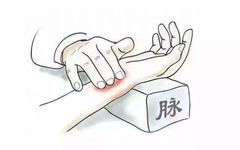
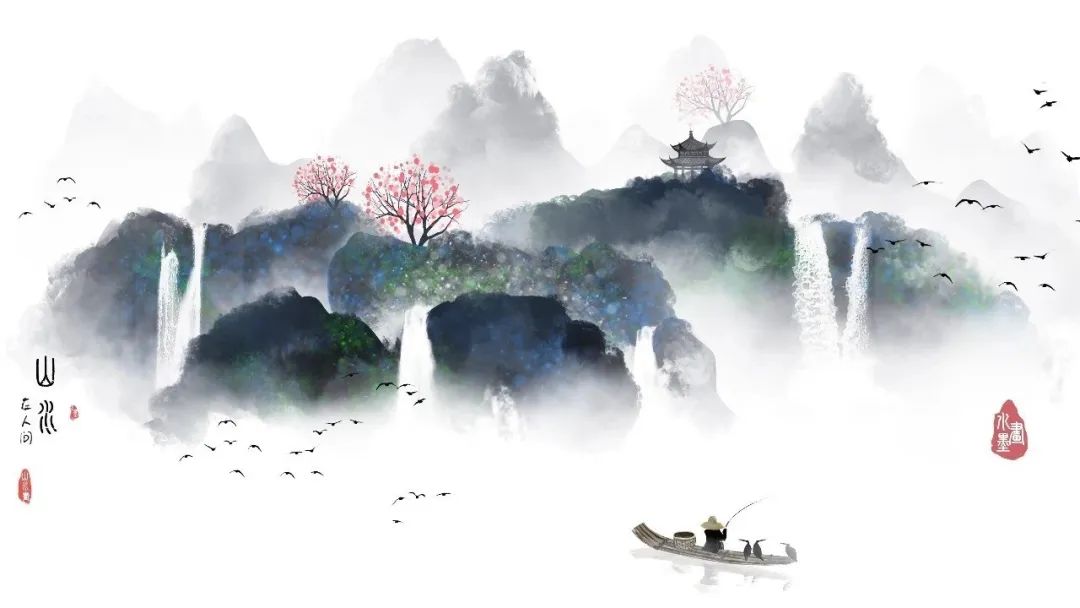
Introduction:
The method of pulse diagnosis in Traditional Chinese Medicine (TCM) refers to the technique where the physician uses their fingers to palpate the patient’s arterial pulse to assess the pulse quality, thereby understanding the patient’s condition.The pulse-taking locations can be categorized into three methods: comprehensive examination, three-position examination, and cun-kou (寸口) examination, with the cun-kou method being the most commonly used.

28 Pulse Types and Pulse Diagnosis Verses
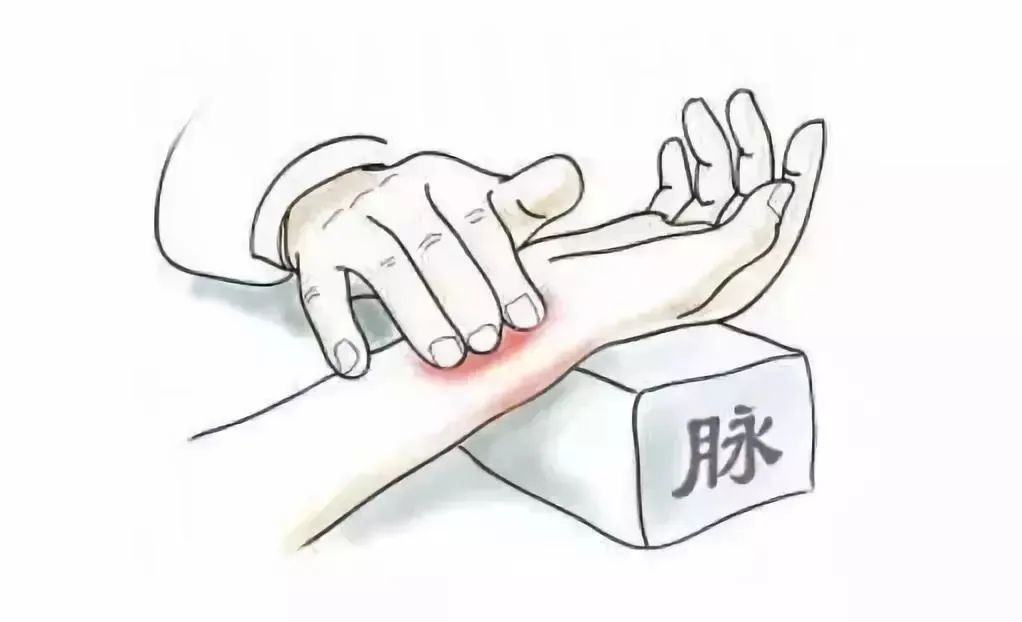
The cun-kou is located at the radial artery pulse point behind both wrists, divided into three sections: cun (寸), guan (关), and chi (尺).The area behind the wrist bone is the guan, the area before it is the cun, and the area behind it is the chi.The cun-kou pulse can reflect the qi of the organs: the left cun reflects the heart and small intestine; the left guan reflects the liver and gallbladder; the left chi reflects the kidney and bladder; the right cun reflects the lung, the right guan reflects the spleen and stomach; the right chi reflects the kidney.
When taking the pulse, attention should be paid to the time, posture, and technique. The examination should be conducted in the morning when the patient is at rest; if the patient has been active, they should rest for about 15 minutes before the pulse diagnosis. The patient can be seated or lying down, with the arm extended and palm facing up, aligning the arm with the heart level. During the pulse-taking, three fingers should press simultaneously, with balanced pressure applied, ranging from light to heavy, categorized into three types of pressure: superficial (浮取), moderate (中取), and deep (沉取).
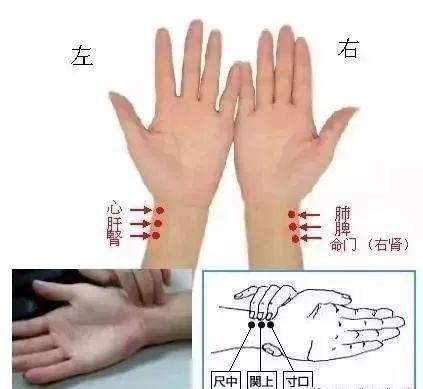
The pulse diagnosis time should not be less than one minute. A healthy pulse should beat four times with each breath, with pulses present in the cun, guan, and chi sections, not floating or sinking, and should be gentle yet strong; the chi pulse should be strong when taken deeply. Common pulse types include floating (浮脉), sinking (沉脉), slow (迟脉), rapid (数脉), weak (虚脉), strong (实脉), slippery (滑脉), surging (洪脉), fine (细脉), and wiry (弦脉).
1. Floating Pulse (浮脉)

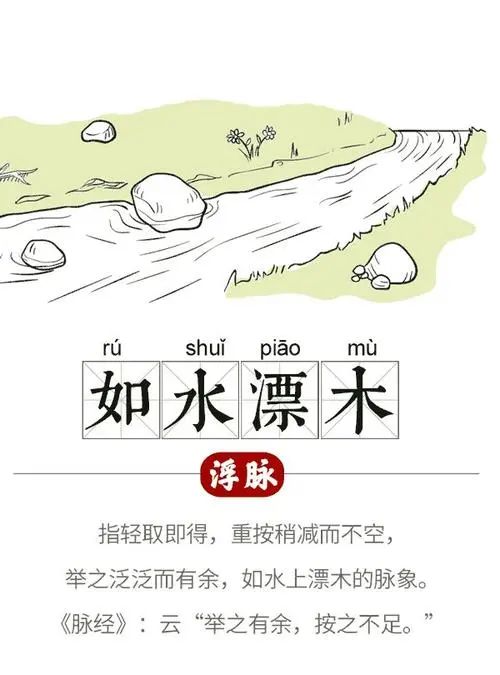
【Body Image Verse】 Floating on the skin, like wood floating on water; it is abundant when lifted, but insufficient when pressed.
【Main Disease Verse】 Floating pulse is yang, indicating a disease on the surface. A floating pulse at the cun indicates wind-cold, with headache and nasal congestion; a floating pulse at the left guan indicates wind in the middle jiao; a floating pulse at the right guan indicates phlegm-wind in the diaphragm; a floating pulse at the chi indicates wind in the lower jiao, with difficulty in urination and constipation.
【Accompanying Pulse Verse】 Weak indicates surface deficiency, strong indicates surface excess. Floating tight indicates wind-cold, floating slow indicates wind-stroke; floating rapid indicates wind-heat, floating slow indicates wind-damp. Floating empty indicates blood loss, floating short indicates shortness of breath; floating surging indicates empty heat, floating weak indicates heat exhaustion; floating rough indicates blood injury, floating moist indicates qi failure.
2. Sinking Pulse (沉脉)
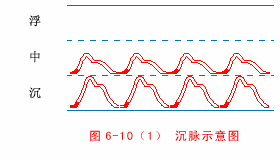
【Body Image Verse】 Sinking travels through the muscles and bones, like a stone thrown into water; it is abundant when pressed, but insufficient when lifted.
【Main Disease Verse】 Sinking pulse is yin, indicating a disease within. A sinking pulse at the cun indicates shortness of breath and chest pain; it may be phlegm or fluid. The guan indicates internal cold, causing pain and fullness; it may be phlegm or fluid. The chi indicates back pain, also indicating waist and knee issues; it may indicate damp-heat or dysuria.
【Accompanying Pulse Verse】 Weak indicates internal deficiency, strong indicates internal excess. Sinking slow indicates chronic cold, sinking rapid indicates internal heat; sinking slippery indicates phlegm or fluid, sinking rough indicates blood stasis; sinking weak indicates deficiency, sinking solid indicates accumulation; sinking tight indicates cold pain, sinking slow indicates damp-cold.
3. Slow Pulse (迟脉)
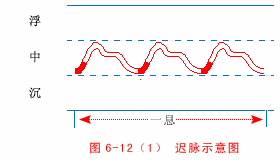
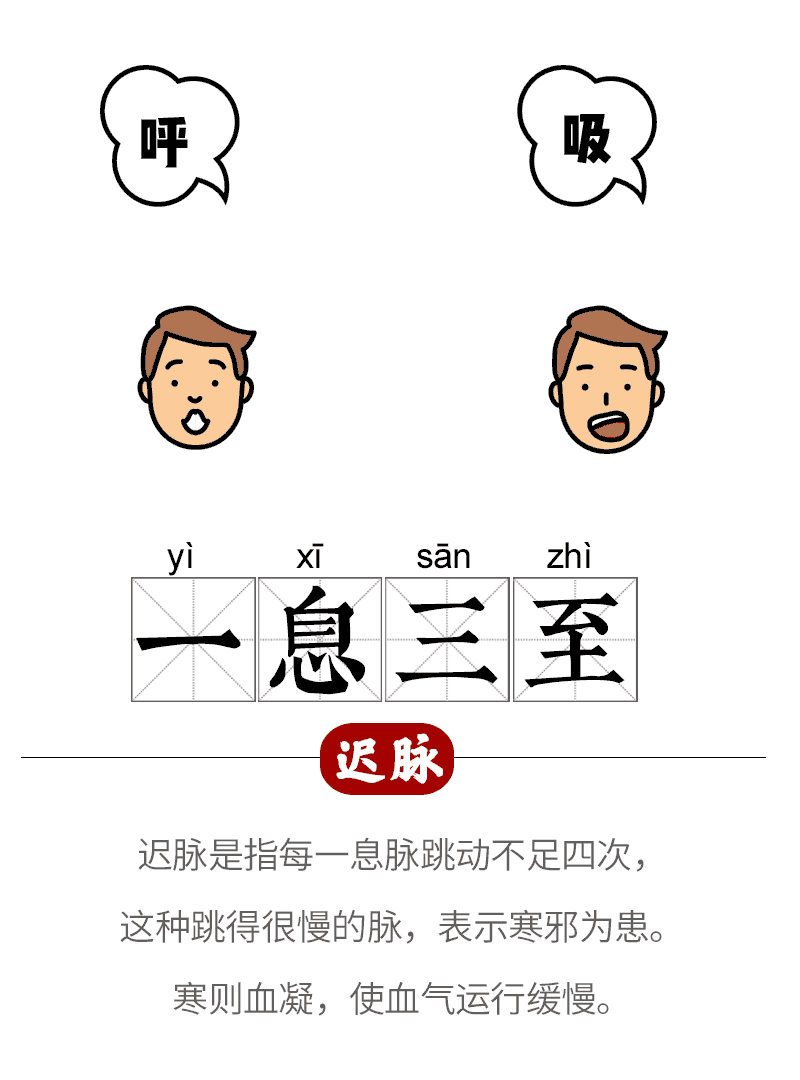
【Body Image Verse】 Slow pulse belongs to yin, characterized by insufficient frequency; it beats slowly, three times per breath.
【Main Disease Verse】 Slow pulse indicates organ issues, with cold as the underlying cause. A slow pulse at the cun indicates upper cold, with chest pain; a slow pulse at the guan indicates middle cold, with muscle spasms; a slow pulse at the chi indicates fire deficiency, with difficulty in urination and defecation, or pain in the waist and feet.
【Accompanying Pulse Verse】 Strong indicates accumulation of cold, weak indicates deficiency of cold. Floating slow indicates surface cold, sinking slow indicates internal cold; slow rough indicates blood deficiency, slow weak indicates damp-cold; slow slippery indicates fullness, slow faint indicates difficulty in stability.
4. Rapid Pulse (数脉)

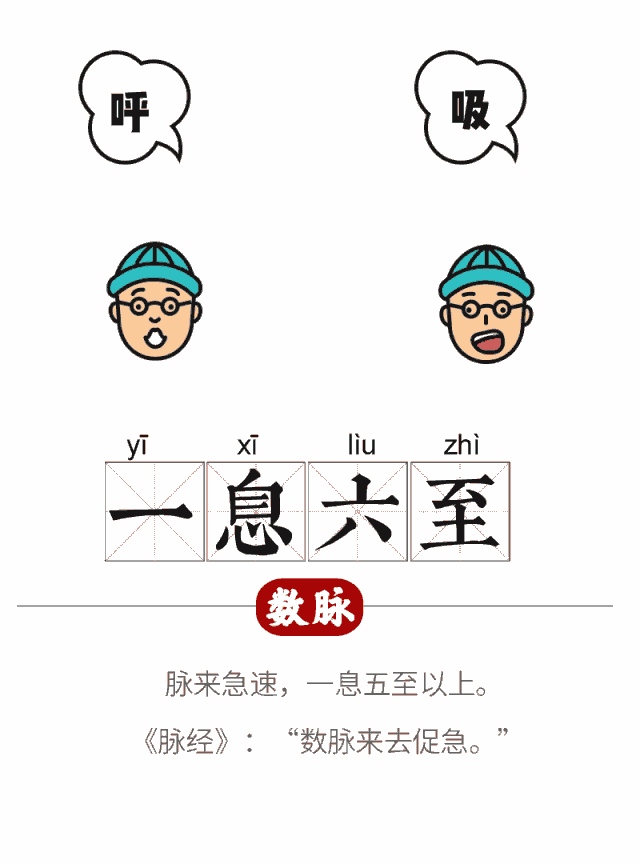
【Body Image Verse】 Rapid pulse belongs to yang, characterized by excessive frequency; it beats six times per breath, fluctuating rapidly.
【Main Disease Verse】 Rapid pulse indicates issues with the bowels, with heat as the underlying cause. A rapid pulse at the cun indicates wheezing and coughing, with mouth sores; a rapid pulse at the guan indicates stomach heat, with upward fire; a rapid pulse at the chi indicates relative fire, with dysuria.
【Accompanying Pulse Verse】 Strong indicates excess fire, weak indicates deficiency fire. Floating rapid indicates surface heat, sinking rapid indicates internal heat. Yang rapid indicates excessive fire, yin rapid indicates relative fire. Right rapid indicates excessive fire, left rapid indicates yin damage.
5. Slippery Pulse (滑脉)
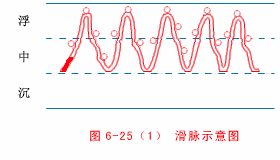
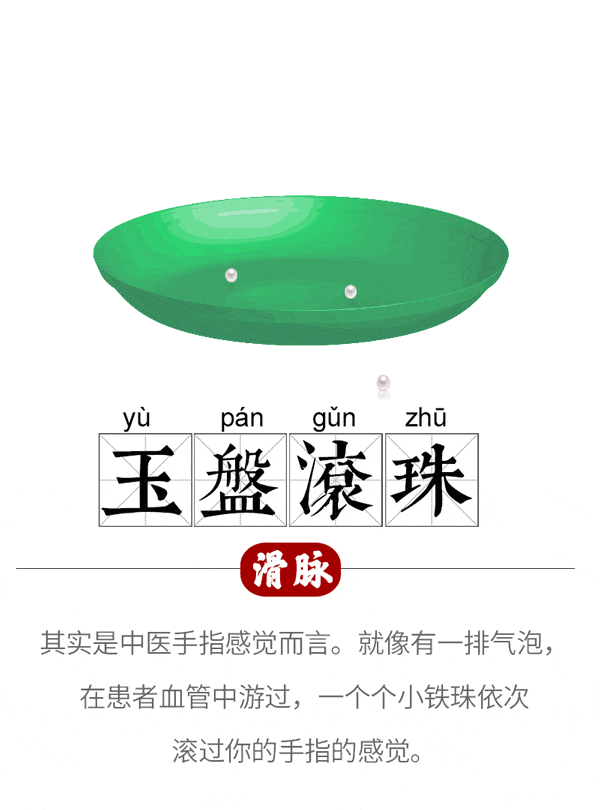
【Body Image Verse】 Slippery pulse flows smoothly, like beads rolling; it has the shape of a pearl, indicating the essence of dew.
【Main Disease Verse】 Slippery pulse is yang, often indicating phlegm and fluid. A slippery pulse at the cun indicates coughing; at the guan indicates stomach heat, with food stagnation; at the chi indicates dysuria, or may indicate dysentery or blood in urine.
【Accompanying Pulse Verse】 Floating slippery indicates wind-phlegm, sinking slippery indicates phlegm-food. Slippery rapid indicates phlegm-fire, slippery short indicates breath obstruction. Slippery and floating indicates pain in the lower abdomen. Slippery and harmonious indicates pregnancy can be confirmed.
6. Rough Pulse (涩脉)

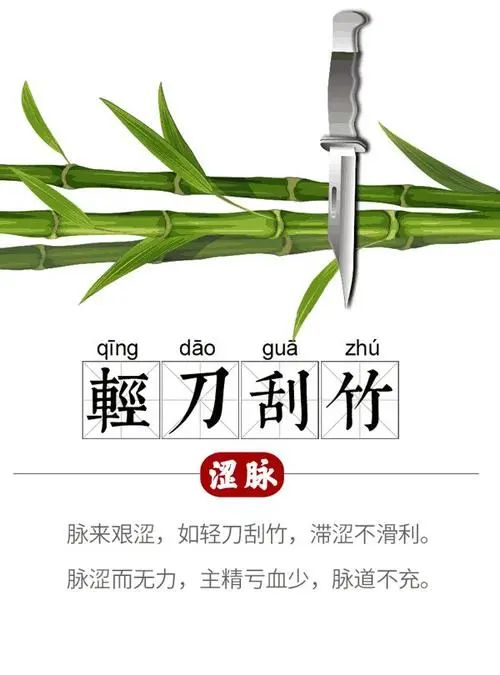
【Body Image Verse】 Rough pulse is stagnant, like a knife scraping bamboo; it is slow and fine, with three characteristics of fear.
【Main Disease Verse】 Rough indicates blood deficiency, also indicating essence injury. A rough pulse at the cun indicates heart pain, or palpitations. A rough pulse at the guan indicates yin deficiency, causing internal heat; right guan indicates earth deficiency, left guan indicates fullness. A rough pulse at the chi indicates dysuria, with blood in urine; pregnancy indicates fetal issues, with blood loss.
【Accompanying Pulse Verse】 Rough and strong indicates excess heat; rough and weak indicates deficiency fire.
7. Weak Pulse (虚脉)


【Body Image Verse】 Weak pulse is small and soft, barely felt; it is difficult to perceive when lifted, but can be felt when pressed.
【Main Disease Verse】 Weak indicates yang deficiency, with true qi weakness. A weak pulse at the cun indicates heart deficiency, with palpitations; at the right cun indicates lung deficiency, with spontaneous sweating and shortness of breath. A weak pulse at the left guan indicates liver injury, with blood not nourishing the muscles; at the right guan indicates spleen cold, with poor digestion. A weak pulse at the left chi indicates kidney deficiency, with weakness in the waist and knees; at the right chi indicates fire deficiency, with cold symptoms.
8. Strong Pulse (实脉)
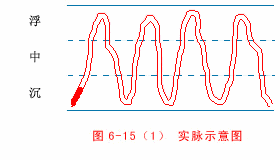
【Body Image Verse】 Strong pulse is powerful, long and firm; it responds strongly to pressure, with all three positions being the same.
【Main Disease Verse】 Strong pulse indicates blood excess, with heat and obstruction. A strong pulse at the left cun indicates heart strain, with tongue strength and qi surging; at the right cun indicates lung disease, with nausea and throat pain. A strong pulse at the left guan indicates liver fire, with side pain; at the right guan indicates fullness and pain. A strong pulse at the left chi indicates constipation and abdominal pain; at the right chi indicates excessive fire.
【Accompanying Pulse Verse】 Strong and tight indicates cold accumulation; strong and slippery indicates phlegm obstruction.
9. Long Pulse (长脉)
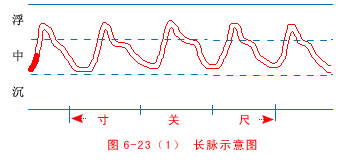
【Body Image Verse】 Long pulse is elongated, with both ends being distinct; it moves straight up and down, like following a long pole.
【Main Disease Verse】 Long indicates excess, with qi reversal and excessive fire. A long pulse at the left cun indicates excessive fire; at the right cun indicates fullness and reversal. A long pulse at the left guan indicates wood excess; at the right guan indicates earth fullness and bloating. A long pulse at the left chi indicates excessive movement; at the right chi indicates excessive fire.
10. Short Pulse (短脉)
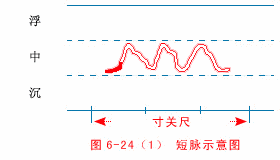
【Body Image Verse】 Short pulse is small and rough, with both ends being low; it is raised in the middle, unable to fill the entire area.
【Main Disease Verse】 Short indicates insufficiency, indicating qi deficiency. A short pulse at the cun indicates heart instability; at the right cun indicates lung deficiency with headache. A short pulse at the left guan indicates liver qi injury; at the right guan indicates issues in the diaphragm. A short pulse at the left chi indicates lower abdominal pain; at the right chi indicates insufficient fire.
11. Surging Pulse (洪脉)

【Body Image Verse】 Surging pulse is extremely large, resembling a flood; it comes strong and goes weak, flowing abundantly.
【Main Disease Verse】 Surging indicates fullness, with qi obstruction and excessive fire. A surging pulse at the left cun indicates heart agitation; at the right cun indicates chest fullness and qi reversal. A surging pulse at the left guan indicates excessive wood; at the right guan indicates excessive heat in the spleen. A surging pulse at the left chi indicates dryness; at the right chi indicates excessive fire.
12. Faint Pulse (微脉)
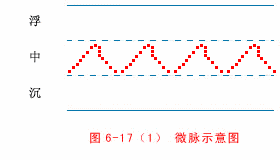
【Body Image Verse】 Faint pulse is extremely fine and soft; it is barely perceptible, almost non-existent.
【Main Disease Verse】 Faint pulse indicates severe qi and blood deficiency. A faint pulse at the left cun indicates fright; at the right cun indicates shortness of breath. A faint pulse at the left guan indicates cold cramps; at the right guan indicates stomach cold. A faint pulse at the left chi indicates severe deficiency; at the right chi indicates life-threatening conditions.
13. Fine Pulse (细脉)
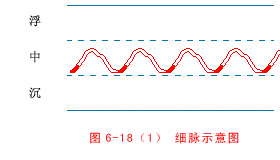
【Body Image Verse】 Fine pulse is straight and soft, winding and coiling; it resembles a silk thread, more pronounced than faint.
【Main Disease Verse】 Fine indicates qi deficiency, with various forms of weakness. A fine pulse at the left cun indicates palpitations and insomnia; at the right cun indicates nausea and shortness of breath. A fine pulse at the left guan indicates liver yin deficiency; at the right guan indicates stomach fullness. A fine pulse at the left chi indicates diarrhea and seminal emission; at the right chi indicates cold and fatigue.
14. Moist Pulse (濡脉)

【Body Image Verse】 Moist pulse is fine and soft, appearing in the floating section; it is visible when lifted, but disappears when pressed.
【Main Disease Verse】 Moist indicates yin deficiency, with essence injury. A moist pulse at the left cun indicates forgetfulness and palpitations; at the right cun indicates spontaneous sweating. A moist pulse at the left guan indicates blood not nourishing the muscles; at the right guan indicates spleen deficiency with dampness. A moist pulse at the left chi indicates essence and blood deficiency; at the right chi indicates fire failure and life-threatening conditions.
15. Weak Pulse (弱脉)
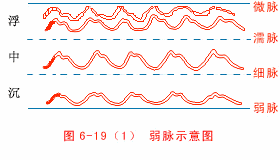
【Body Image Verse】 Weak pulse is small and soft, felt in the sinking section; it is imperceptible when lifted, but can be felt when pressed.
【Main Disease Verse】 Weak indicates yang collapse, with true qi weakness. A weak pulse at the left cun indicates heart deficiency, with palpitations; at the right cun indicates lung deficiency, with spontaneous sweating and shortness of breath. A weak pulse at the left guan indicates wood deficiency, with pain; at the right guan indicates earth cold, with digestive issues. A weak pulse at the left chi indicates severe deficiency; at the right chi indicates yang collapse.
16. Tight Pulse (紧脉)
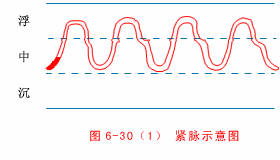
【Body Image Verse】 Tight pulse is strong, with a snapping quality; it feels like a twisted rope or a tightly pulled string.
【Main Disease Verse】 Tight indicates cold evil, also indicating various pains. A tight pulse at the left cun indicates fullness and pain; at the right cun indicates cold damage with wheezing. A tight pulse at the left guan indicates floating tightness due to cold; at the right guan indicates sinking tightness due to food stagnation. A tight pulse at the left chi indicates severe pain; at the right chi indicates excessive movement.
17. Slow Pulse (缓脉)
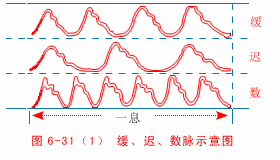
【Body Image Verse】 Slow pulse is gentle, with a harmonious rhythm; it flows like a light breeze in early spring.
【Main Disease and Accompanying Pulse Verse】 Slow indicates stomach qi, not indicating disease; it should be assessed in conjunction with other pulses. Floating slow indicates wind damage, sinking slow indicates cold dampness. Slow strong indicates wind deficiency, slow fine indicates dampness. Right cun floating slow indicates wind evil; left cun rough slow indicates yin blood deficiency. Left guan floating slow indicates liver wind; right guan sinking slow indicates weakness from dampness. Left chi slow indicates essence deficiency; right chi slow indicates severe yang deficiency.
18. Wiry Pulse (弦脉)
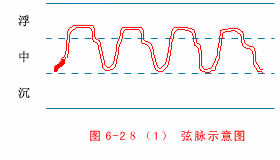
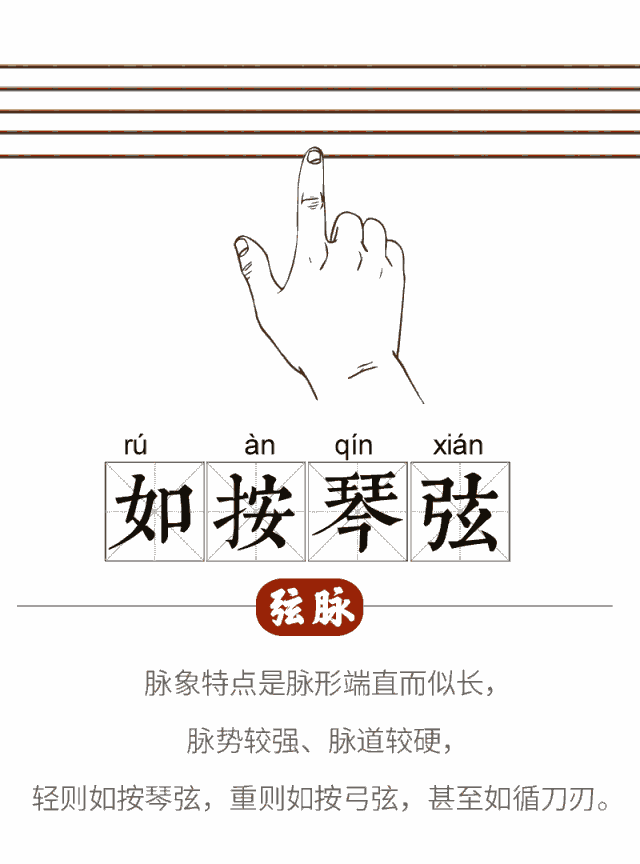
【Body Image Verse】 Wiry pulse resembles a string, light and slippery; it is straight and long, with a firm touch.
【Main Disease Verse】 Wiry indicates liver wind, indicating pain, malaria, phlegm, and fluid. A wiry pulse at the left cun indicates heart pain; at the right cun indicates chest and head pain. A wiry pulse at the left guan indicates phlegm and malaria; at the right guan indicates stomach cold pain. A wiry pulse at the left chi indicates fluid in the lower jiao; at the right chi indicates foot cramps and hernia.
【Accompanying Pulse Verse】 Floating wiry indicates fluid retention, sinking wiry indicates suspended fluid. Wiry rapid indicates heat, wiry slow indicates cold. Wiry strong indicates deficiency, wiry fine indicates tightness. Yang wiry indicates headache, yin wiry indicates abdominal pain. Single wiry indicates fluid retention, double wiry indicates cold accumulation.
19. Moving Pulse (动脉)
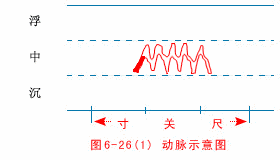
【Body Image Verse】 Moving pulse has no beginning or end, moving like a bean; it shakes and trembles, often accompanied by slippery and rapid.
【Main Disease Verse】 Moving pulse indicates pain, also indicating fright. A moving pulse at the left cun indicates fright; at the right cun indicates spontaneous sweating. A moving pulse at the left guan indicates fright and cramps; at the right guan indicates heart and spleen pain. A moving pulse at the left chi indicates loss of essence; at the right chi indicates excessive fire.
20. Rapid Pulse (促脉)
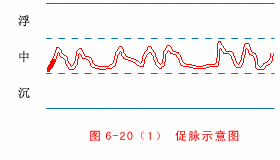
【Body Image Verse】 Rapid pulse is quick and urgent, with intermittent stops; it is like rushing and stumbling, advancing leads to danger.
【Main Disease Verse】 Rapid indicates excessive fire, also due to stagnation. A rapid pulse at the left cun indicates heart fire; at the right cun indicates lung wheezing. A rapid pulse at the left guan indicates blood stagnation; at the right guan indicates food stagnation. A rapid pulse at the left chi indicates slippery and concerning; at the right chi indicates burning heat.
21. Knotted Pulse (结脉)

【Body Image Verse】 Knotted pulse indicates stagnation, with intermittent stops; it moves slowly and lazily, often indicating a specific meaning.
【Main Disease Verse】 Knotted indicates yin cold, also due to accumulation. A knotted pulse at the left cun indicates heart cold, with pain; at the right cun indicates lung deficiency, with qi cold accumulation. A knotted pulse at the left guan indicates hernia; at the right guan indicates phlegm stagnation. A knotted pulse at the left chi indicates weakness; at the right chi indicates yin cold.
22. Intermittent Pulse (代脉)
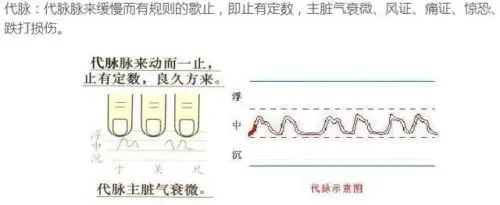
【Body Image Verse】 Intermittent pulse indicates a change, with a constant rhythm; it cannot return to normal, but eventually resumes movement.
【Main Disease Verse】 Intermittent indicates organ failure, a sign of danger. Spleen deficiency leads to vomiting and diarrhea; middle cold leads to poor appetite and abdominal pain. Two movements and one stop indicate death in three to four days; four movements and one stop indicate death in six to seven days. Sequential assessment should not deviate from the principles.
23. Leather Pulse (革脉)
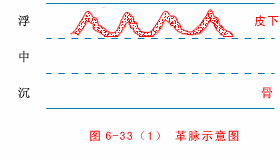
【Body Image Verse】 Leather pulse is large and tense, easily felt; it is empty when pressed, resembling a drum skin.
【Main Disease Verse】 Leather indicates surface cold, also indicating internal deficiency. A leather pulse at the left cun indicates heart blood deficiency; at the right cun indicates metal deficiency with qi obstruction. A leather pulse at the left guan indicates hernia; at the right guan indicates earth deficiency with pain. A leather pulse at the left chi indicates essence emptiness; at the right chi indicates life-threatening conditions. Women with this pulse may experience postpartum hemorrhage.
24. Solid Pulse (牢脉)
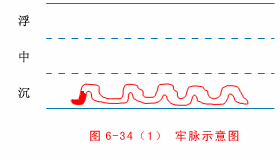
【Body Image Verse】 Solid pulse is felt in the sinking section, large and firm; it is difficult to feel in the floating section.
【Main Disease Verse】 Solid indicates accumulation. A solid pulse at the left cun indicates fullness; at the right cun indicates stable pain. A solid pulse at the left guan indicates liver blood accumulation; at the right guan indicates cold phlegm. A solid pulse at the left chi indicates excessive movement; at the right chi indicates severe pain.
25. Scattered Pulse (散脉)

【Body Image Verse】 Scattered pulse is floating and chaotic, with surface but no interior; it gradually empties, disappearing when pressed.
【Main Disease Verse】 Scattered indicates primary injury, indicating danger. A scattered pulse at the left cun indicates palpitations and insomnia; at the right cun indicates spontaneous sweating. A scattered pulse at the left guan indicates fluid retention; at the right guan indicates fullness and illness. At the left chi, it indicates water depletion; at the right chi, it indicates life-threatening conditions.
26. Hollow Pulse (芤脉)

【Body Image Verse】 Hollow pulse is a type of grass, resembling a green onion; it has both floating and sinking qualities, with the middle section being empty.
【Main Disease Verse】 Hollow pulse indicates emptiness, hence indicating blood loss. A hollow pulse at the left cun indicates heart blood loss; at the right cun indicates yin injury. A hollow pulse at the left guan indicates liver blood not stored; at the right guan indicates spleen blood not absorbed. A hollow pulse at the left chi indicates red urine; at the right chi indicates fire and essence leakage.
27. Hidden Pulse (伏脉)
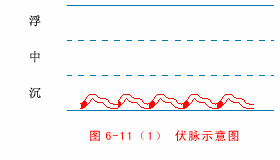
【Body Image Verse】 Hidden pulse is concealed, deeper than sinking; it feels like pressing on the bones to perceive its form.
【Main Disease Verse】 Hidden pulse indicates yin, with deep-seated illness. A hidden pulse at the left cun indicates blood stasis; at the right cun indicates qi stagnation. A hidden pulse at the left guan indicates liver blood in the abdomen; at the right guan indicates cold retention in the stomach. A hidden pulse at the left chi indicates hernia; at the right chi indicates diminished fire.
28. Rapid Pulse (疾脉)

【Body Image Verse】 Rapid pulse is extremely quick, with the highest frequency; it beats seven to eight times, flowing thinly and rapidly.
【Main Disease Verse】 Rapid indicates extreme yang, with yin qi about to deplete; the pulse deviates from the norm, indicating imminent danger. A rapid pulse at the left cun indicates danger; at the right cun indicates excessive fire. A rapid pulse at the left guan indicates liver yin depletion; at the right guan indicates spleen yin depletion. A rapid pulse at the left chi indicates severe depletion; at the right chi indicates excessive heat.

Disclaimer: The images and text are sourced from the internet, with the author unknown, shared for educational purposes, and copyright belongs to the original author. For copyright issues, please contact Ye Xi for resolution.
Mr. Taiyi. Xi Huang Lecture Hall
1. Mr. Taiyi interprets the true essence of Daoism
2. The past and present of the four pure lands in Daoism
3. Understanding quantum mechanics through Daoist symbolism
4. Entering Zhuangzi’s world of Nanhua
5. Mr. Taiyi’s correct interpretation of the “Classic of Purity”
6. Mr. Taiyi’s insightful interpretation of the “Yellow Emperor’s Yin Symbol Classic”
7. Why are there so many differing interpretations of the “Tao Te Ching”?
8. Mr. Taiyi interprets the inheritance and great principles of Daoism



Since ancient times, the practice of Zhu You has occupied a significant place in TCM. What is Zhu You? The “Su Wen: On the Transformation of Essence and Qi” states: “I have heard that in ancient times, the treatment of diseases was solely through the transformation of essence and qi, which could be achieved through Zhu You.” The foundation of transforming essence and qi is the cultivation of the ultimate Dao, and the level of practical cultivation also determines the effectiveness of Zhu You. However, as practitioners have lost the foundation of ultimate Dao cultivation, TCM techniques have also lost the root of Zhu You, leading to gradual decline.
The Daosim Wenshi school’s Great Accomplishment Pure Land method is centered around Zhu You. The core application of Zhu You is medical Zhu You, which involves entering a state of tranquility and clarity under the guidance of a Zhu You master, activating the original qi, and then applying specific healing techniques to naturally resolve physical and mental ailments. The highest level of Zhu You is to lead one to “see the unique”, that is, to perceive the unique original spirit (true mind, true nature). The horizontal application of Zhu You is the end-of-life care technique.
The original intention of great medical Zhu You:
First, I wish for everyone to cultivate themselves, strengthen their bodies, and nurture their nature to achieve physical and mental health, even to live without illness; to diligently study the medical path, to help oneself and others, to avoid the mistakes of mediocre doctors.
Second, I wish for all practitioners to emulate the Medicine King Sun Simiao, with great sincerity, compassion to benefit the world, one hand in ultimate Dao cultivation, comprehending the great principles, and the other hand in healing the world, effectively treating diseases.
Click to learn: Daoist Wenshi School’s Ultimate Dao Cultivation Course

Xi Huang Lao Zhuang’s sudden enlightenment method: The king of all methods is the non-action method, centered around the Three Caves and Four Changes, observing symbols to break through and understand the Dao

The Great Accomplishment Pure Land method combining sudden and gradual: small can achieve physical and mental health, medium can master life and death, large can achieve instant enlightenment



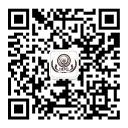
Daoist Wenshi School. Brother Ye Xi
19106776687
Daoist Wenshi method practitioner and promoter
Scan or search WeChat ID:yexi2028

